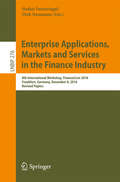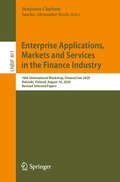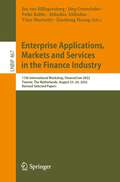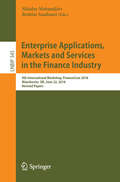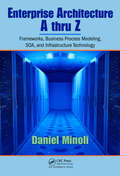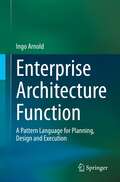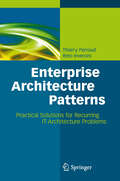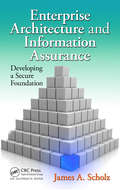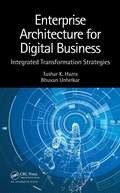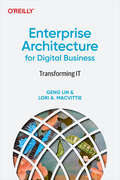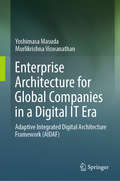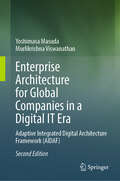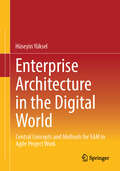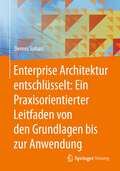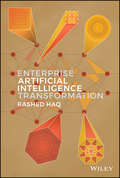- Table View
- List View
Enterprise Applications, Markets and Services in the Finance Industry
by Stefan Feuerriegel Dirk NeumannThis book constitutes revised selected papers from the 8th International Workshop on Enterprise Applications, Markets and Services in the Finance Industry, FinanceCom 2016, held in Frankfurt, Germany, in December 2016. The 2016 workshop especially focused on "The Analytics Revolution in Finance" and brought together leading academics from a broad range of disciplines, including computer science, business studies, media technology and behavioral science, to discuss recent advances in their respective fields. The 9 papers presented in this volume were carefully reviewed and selected from 13 submissions.
Enterprise Applications, Markets and Services in the Finance Industry: 10th International Workshop, FinanceCom 2020, Helsinki, Finland, August 18, 2020, Revised Selected Papers (Lecture Notes in Business Information Processing #401)
by Benjamin Clapham Jascha-Alexander KochThis book constitutes the revised selected papers from the 10th International Workshop on Enterprise Applications, Markets and Services in the Finance Industry, FinanceCom 2020, held in Helsinki, Finland, in August 2020. Due to the COVID-19 pandemic the conference took place virtually.The 6 full papers presented together with 1 extended abstract in this volume were carefully reviewed and selected from a total of 14 submissions to the workshop.They are grouped in topical sections named Machine Learning Applications in Trading and Financial Markets, Fraud Detection and Information Generation in Finance, and Alternative Trading and Investment Offerings by FinTechs.The workshop spans multiple disciplines, including analytical, technical, service, economic, sociological and behavioral sciences.
Enterprise Applications, Markets and Services in the Finance Industry: 11th International Workshop, FinanceCom 2022, Twente, The Netherlands, August 23–24, 2022, Revised Selected Papers (Lecture Notes in Business Information Processing #467)
by Jos Van Hillegersberg Jörg Osterrieder Fethi Rabhi Abhishta Abhishta Vijay Marisetty Xiaohong HuangThis book constitutes revised selected papers from the 11th International Workshop on Enterprise Applications, Markets and Services in the Finance Industry, FinanceCom 2022, held in Twente, The Netherlands, in August 2022.The 8 full papers presented in this volume were carefully reviewed and selected from a total of 25 submissions. They deal with the adoption of innovative technologies in the financial services industry. The conference features four main themes: networks and business models, financial markets, IT and implementations, and new emerging digital and virtual financial markets.
Enterprise Applications, Markets and Services in the Finance Industry: 12th International Workshop, FinanceCom 2024, Copenhagen, Denmark, October 10, 2024, Revised Selected Papers (Lecture Notes in Business Information Processing #541)
by Jonas Hedman Rob Gleasure Madhushi BandaraThis book constitutes revised selected papers from the 12th International Workshop on Enterprise Applications, Markets and Services in the Finance Industry, FinanceCom 2024, held in Copenhagen, Denmark, on October 10, 2024. The 5 full papers presented in this volume were carefully reviewed and selected from a total of 8 submissions. They deal with the adoption of innovative technologies in the financial services industry. In addition, two invited papers which are closely related with the conference topics were also included after a thorough review. The conference features five main themes: networks and business models, financial markets, IT and implementations, new emerging digital and virtual financial markets, and AI revolution in finance.
Enterprise Applications, Markets and Services in the Finance Industry: 9th International Workshop, FinanceCom 2018, Manchester, UK, June 22, 2018, Revised Papers (Lecture Notes in Business Information Processing #345)
by Nikolay Mehandjiev Brahim SaadouniThis book constitutes revised selected papers from the 9th International Workshop on Enterprise Applications, Markets and Services in the Finance Industry, FinanceCom 2018, held in Manchester, UK, in June 2018. The 11 papers presented in this volume were carefully reviewed and selected from 18 submissions. They were organized in topical sections named: financial innovation; market data analytics; and semantic modelling.
Enterprise Architecture A to Z: Frameworks, Business Process Modeling, SOA, and Infrastructure Technology
by Daniel MinoliEnterprise Architecture A to Z examines cost-saving trends in architecture planning, administration, and management. The text begins by evaluating the role of Enterprise Architecture planning and Service-Oriented Architecture (SOA) modeling. It provides an extensive review of the most widely-deployed architecture framework models, including The Open Group Architecture and Zachman Architectural Frameworks, as well as formal architecture standards. The first part of the text focuses on the upper layers of the architecture framework, while the second part focuses on the technology architecture. Additional coverage discusses Ethernet, WAN, Internet communication technologies, broadband, and chargeback models.
Enterprise Architecture As Strategy
by David Robertson Jeanne W. Ross Peter WeillDoes it seem you've formulated a rock-solid strategy, yet your firm still can't get ahead? If so, construct a solid foundation for business execution-an IT infrastructure and digitized business processes to automate your company's core capabilities. In Enterprise Architecture as Strategy: Creating a Foundation for Business Execution, authors Jeanne W. Ross, Peter Weill, and David C. Robertson show you how.The key? Make tough decisions about which processes you must execute well, then implement the IT systems needed to digitize those processes. Citing numerous companies worldwide, the authors show how constructing the right enterprise architecture enhances profitability and time to market, improves strategy execution, and even lowers IT costs. Though clear, engaging explanation, they demonstrate how to define your operating model-your vision of how your firm will survive and grow-and implement it through your enterprise architecture. Their counterintuitive but vital message: when it comes to executing your strategy, your enterprise architecture may matter far more than your strategy itself.
Enterprise Architecture Frameworks Kompendium
by Dirk MatthesIn dem Band werden 50 Enterprise Architecture Frameworks (EAF) ausführlich behandelt und 45 weitere hinsichtlich ihrer Intention kurz und prägnant dargestellt. Die detaillierten Beschreibungen erlauben durch ein einheitliches Raster den Vergleich unterschiedlicher EAF. Sie enthalten Informationen zum Entwickler, zu Versionen, zur Marktrelevanz, zu Abhängigkeiten, Verfügbarkeit, unterstützenden Tools sowie Anschaffungskosten. Die Unterstützungsvielfalt, die Frameworks bieten, demonstriert der Autor anhand eines Anwendungsszenarios.
Enterprise Architecture Function: A Pattern Language for Planning, Design and Execution
by Ingo ArnoldThis book provides a method to plan, develop, validate, or evolve the design of an enterprise architecture function so that it fully meets the organization’s needs. The reader will benefit from this book in two ways. First, it provides a structured overview and orientation to the subject of architecture from an architecture function perspective. Second, it guides through the process of planning, building, and operating your own architecture organization based on a generic architecture function blueprint presented in the form of a pattern language offering a structured means for navigating, contextualizing, combining, and composing the architecture function patterns. The book is structured in six chapters. Chapter 1 “Introduction” explains the starting position and objectives of the book and introduces key concepts that will be explained further in subsequent chapters. Chapter 2 “Architecture Function Pattern Language” introduces the concepts of pattern, pattern catalogue, pattern topology, and ontology and explains how these concepts are combined to form a pattern language for planning, designing, and operating an architecture function. Next, Chapter 3 “Architecture Function – Context“ introduces concepts that are crucial for understanding the challenges that an architecture function faces and presents a generic schema for the business organizations and value chain. Chapter 4 “Architecture Function – Challenge” looks at an architecture function from a black box perspective and outlines the expectations and requirements that companies place on architecture organizations. It discusses the building blocks of an architecture function, the services it provides along the enterprise value chain, and the quality attributes that enterprises expect from their functions. Chapter 5 “Architecture Function – Constitution” then shifts from a black-box perspective to a white-box perspective and outlines the generic design of an architecture function in order to realize functional and quality-related requirements. Chapter 6 “Pattern Catalogue“ eventually introduces the pattern catalogue with a total of 48 architecture function patterns. These patterns suggest designs for collaboration between the architecture function and enterprise organizations, for the elaboration and development of enterprise services along the enterprise value chain, or for aligning architecture governance with enterprise governance. The book is intended for a broad readership, including enterprise, domain, and solution architects, lecturers and students, and anyone else interested in understanding the value proposition, responsibilities, outcomes, methods, and practices of architecture functions. It introduces the basic concepts and theories needed to understand the pattern language presented and the patterns it summarizes.
Enterprise Architecture Patterns: Practical Solutions for Recurring IT-Architecture Problems
by Reto Inversini Thierry PerroudEvery enterprise architect faces similar problems when designing and governing the enterprise architecture of a medium to large enterprise. Design patterns are a well-established concept in software engineering, used to define universally applicable solution schemes. By applying this approach to enterprise architectures, recurring problems in the design and implementation of enterprise architectures can be solved over all layers, from the business layer to the application and data layer down to the technology layer. Inversini and Perroud describe patterns at the level of enterprise architecture, which they refer to as Enterprise Architecture Patterns. These patterns are motivated by recurring problems originating from both the business and the underlying application, or from data and technology architectures of an enterprise such as identity and access management or integration needs. The Enterprise Architecture Patterns help in planning the technological and organizational landscape of an enterprise and its information technology, and are easily embedded into frameworks such as TOGAF, Zachman or FEA. This book is aimed at enterprise architects, software architects, project leaders, business consultants and everyone concerned with questions of IT and enterprise architecture and provides them with a comprehensive catalogue of ready-to-use patterns as well as an extensive theoretical framework to define their own new patterns.
Enterprise Architecture and Cartography: From Practice to Theory; From Representation to Design (The Enterprise Engineering Series)
by Pedro Sousa André VasconcelosThis textbook provides guidance to both students and practitioners of enterprise architecture (EA) on how to develop and maintain enterprise models. Rather than providing yet another list of EA notations and frameworks from A to Z, it focuses on methods to perform such tasks. The problem of EA maintenance, named Enterprise Cartography, is an important aspect addressed in this book because EA is a never ending challenge that increases as the organization transformations pace also increases. The long time perspective also entails the evolution of architectural frameworks and notations, something that does not occur when developing new models. Thus, a catalogue of patterns, principles and methods is presented to develop and maintain EA models and views. After a general introduction to the book in chapter 1, chapter 2 presents basic concepts for EA modeling. Chapter 3 further details the set of EA concepts needed to present the patterns, and principles, which are subsequently introduced in chapter 4. Next, chapter 5 describes enterprise cartography concepts and principles. The remaining book then turns to techniques and methodologies. In chapter 6 an EA development method is summarized. In chapter 7 an enterprise strategy design approach is proposed, while in chapter 8 a business process design methodology is described. Chapters 9 and 10 focus on information architecture and information systems architecture design approaches, including information systems architecture planning and application portfolio management. Eventually, chapter 11 describes a method for enterprise cartography (EC) design. Last not least, several case studies on EA and EC are proposed in the last chapter.
Enterprise Architecture and Information Assurance: Developing a Secure Foundation
by James A. ScholzThis book provides guidance on designing complex, highly available enterprise architectures that integrate the most critical aspects of an organization's business processes. Considering the lack of tolerance of enterprise for operational interruptions or the risks that accompany theft and loss of data, this reference describes how to ensure your organization is prepared for the unexpected. The text also aids in containing liability with guidance on network and application vulnerability assessments, intrusion detection and penetration testing, incident response planning, risk mitigation audits/reviews, and business continuity and disaster recovery planning.
Enterprise Architecture and New Generation Information Systems
by Dimitris N. ChorafasBased on an extensive research project done by the author in the United States, Britain, Germany, France, Switzerland, Sweden, and Austria from December 1999 to June 2001, Enterprise Architecture and New Generation Information Systems focuses on four main themes: Next Generation Information Technology The Likely Technologies
Enterprise Architecture at Work: Modelling, Communication and Analysis
by Marc LankhorstAn enterprise architecture tries to describe and control an organisation's structure, processes, applications, systems and techniques in an integrated way. The unambiguous specification and description of components and their relationships in such an architecture requires a coherent architecture modelling language. Lankhorst and his co-authors present such an enterprise modelling language that captures the complexity of architectural domains and their relations and allows the construction of integrated enterprise architecture models. They provide architects with concrete instruments that improve their architectural practice. As this is not enough, they additionally present techniques and heuristics for communicating with all relevant stakeholders about these architectures. Since an architecture model is useful not only for providing insight into the current or future situation but can also be used to evaluate the transition from 'as-is' to 'to-be', the authors also describe analysis methods for assessing both the qualitative impact of changes to an architecture and the quantitative aspects of architectures, such as performance and cost issues. The modelling language presented has been proven in practice in many real-life case studies and has been adopted by The Open Group as an international standard. So this book is an ideal companion for enterprise IT or business architects in industry as well as for computer or management science students studying the field of enterprise architecture.
Enterprise Architecture for Digital Business: Integrated Transformation Strategies
by Bhuvan Unhelkar Tushar K. HazraEnterprise Architecture (EA) is an essential part of the fabric of a business; however, EA also transcends and transforms technology and moves it into the business space. Therefore, EA needs to be discussed in an integrated, holistic, and comprehensive manner. Only such an integrated approach to EA can provide the foundation for a transformation that readies the business for the myriad enterprise-wide challenges it will face. Highly disruptive technologies such as Big Data, Machine Learning, and Mobile and Cloud Computing require a fine balance between their business and technical aspects as an organization moves forward with its digital transformation. This book focuses on preparing all organizations – large and small – and those wishing to move into them for the impact of leveraging these emerging, disruptive, and innovative technologies within the EA framework.
Enterprise Architecture for Digital Business: Transforming IT
by Geng Lin Lori A. MacVittieDigital transformation has accelerated nearly tenfold in recent years as both a business and technology journey. Yet, most white papers and how-to guides still focus solely on the business side, rather than include methods for optimizing the technology behind it. This handbook shows CIOs, IT directors, and architects how to balance these two concerns successfully.You'll explore current technology trends and shifts required to build a digital business, including how enterprise architecture should evolve if it's to sustain and grow your business. A CIO who can handle digital transformation along with business interests is a rare find. This is the ideal guide to modernizing IT.You'll examine:The latest trends and technologies driving the need for a digital enterprise architectureNew components, layers, and concepts that comprise a framework for digital enterprise architectureSkills and technologies you need to modernize an enterprise architecture for a digital businessDomains and characteristics of a digital enterprise architectureHow to map digital enterprise technologies to the appropriate teams
Enterprise Architecture for Global Companies in a Digital IT Era: Adaptive Integrated Digital Architecture Framework (AIDAF)
by Yoshimasa Masuda Murlikrishna ViswanathanThis book investigates solutions incorporated by architecture boards in global enterprises to resolve issues and mitigate related architecture risks, while also proposing and implementing an adaptive integrated digital architecture framework (AIDAF) and related models and approaches/platforms, which can be applied in companies to promote IT strategies using cloud/mobile IT/digital IT. The book is divided into three main parts, the first of which (Chapters 1–2) addresses the background and motivation for AIDAF aligned with digital IT strategies. The second part (Chapter 3) provides an overview of strategic enterprise architecture (EA) frameworks for digital IT, elaborates on the essential elements of EA frameworks in the digital IT era, and advocates using AIDAF, models for architecture assessment/risk management, knowledge management on digital platforms. In turn, the third part (Chapters 4–7) demonstrates the application and benefits of AIDAF and related models, as shown in three case studies. “I found this book to be a very nice contribution to the EA community of practice. I can recommend this book as a textbook for digital IT strategists/practitioners, EA practitioners, students in universities and graduate schools.” (From the Foreword by Scott A. Bernard) “In this new age of the digital information society, it is necessary to advocate a new EA framework. This book provides state-of-the art knowledge and practices about EA frameworks beneficial for IT practitioners, IT strategists, CIO, IT architects, and even students. It serves as an introductory textbook for all who drive the information society in this era.”(From the Foreword by Jun Murai)
Enterprise Architecture for Global Companies in a Digital IT Era: Adaptive Integrated Digital Architecture Framework (AIDAF)
by Yoshimasa Masuda Murlikrishna ViswanathanThis book investigates solutions incorporated by architecture boards in global enterprises to resolve issues and mitigate related architecture risks, while also proposing and implementing an adaptive integrated digital architecture framework (AIDAF) and related models and approaches/platforms covering Big Data and AI such as Generative AI, unstructured data analytics and HCI-AI, etc., which can be applied in companies to promote IT strategies using cloud/mobile IT/digital IT. The book is divided into three main parts, the first of which (Chapters 1–2) addresses the background and motivation for AIDAF aligned with digital IT strategies, while involving AI and Design Thinking approach. The second part (Chapter 3) provides an overview of strategic enterprise architecture (EA) frameworks for digital IT, elaborates on the essential elements of EA frameworks in the digital IT era, and advocates using AIDAF, models for architecture assessment/risk management, and knowledge management on digital platforms, while involving the new models' introduction with Design Thinking approach covering AI and Digital Transformation process. In turn, the third part (Chapters 4–9) demonstrates the application and benefits of AIDAF and related models involving the above new ones for AI and Digital Transformation process, as shown in more than six case studies. &“I found this book to be a very nice contribution to the EA community of practice. I can recommend this book as a textbook for digital IT strategists/practitioners, EA practitioners, students in universities and graduate schools.&” (From the Foreword by Scott A. Bernard) &“In this new age of the digital information society, it is necessary to advocate a new EA framework. This book provides state-of-the art knowledge and practices about EA frameworks beneficial for IT practitioners, IT strategists, CIO, IT architects, and even students. It serves as an introductory textbook for all who drive the information society in this era.&”(From the Foreword by Jun Murai)
Enterprise Architecture in the Digital World: Central Concepts and Methods for EAM in Agile Project Work
by Hüseyin YükselHow do companies achieve the transformation into an agile, innovative, digital business and work environment? This question concerns not only IT managers but also strategic players, the enterprise architects. They must bridge the gap between strategic planning and dealing with increasing speed and growing uncertainty. Holistic enterprise development in the digital future means developing digital ecosystems and complex IT landscapes. This book presents methods and concepts from the agile world, semiotics, and neuropsychology that can help enterprise architects in their practical everyday work. Starting from a positive view of humanity, it is possible to harness the potential of individuals and teams for digital transformation with fundamental knowledge. The book is primarily aimed at IT managers, enterprise architects, and managers involved in large-scale software development processes. Many practical examples illustrate the theoretically presented connections and provide broader access to enterprise architecture management.
Enterprise Architektur entschlüsselt: Ein Praxisorientierter Leitfaden von den Grundlagen bis zur Anwendung
by Dennis SuhariEntdecken Sie "Enterprise Architektur entschlüsselt: Ein praxisorientierter Leitfaden von den Grundlagen bis zur Anwendung“ von Dennis Suhari, ein praxisorientiertes Werk, das die Förderung des Bewusstseins für Enterprise Architektur, die Vermittlung praktischer Erfahrungen und die Unterstützung der Leser bei der erfolgreichen Anwendung ihres Wissens in den Mittelpunkt stellt. Ein Schlüsselelement dieses Buches ist das praxisnahe Fallbeispiel, das einen einzigartigen Einblick in den Aufbau einer Enterprise Architektur von der Geschäfts- über die IT Architektur von Grund auf bietet.Was Sie erwartet:Fundamentale Grundlagen: Ein tiefgreifender Einblick in die essenziellen Grundlagen der Unternehmensarchitektur, um Schlüsselkonzepte und Prinzipien zu vermitteln, die als robuste Basis für die weitere Entwicklung dienen.Modellierung und praktische Tools: Entdecken Sie vielfältige Modellierungsmöglichkeiten und EAM-Tools, die inder Praxis zur Unterstützung der Architekturentwicklung eingesetzt werden.Architekturentwicklung in der Praxis: Anhand des Fallbeispiels der fiktiven Micayu GmbH, basierend auf den umfangreichen Erfahrungen des Autors, erleben Sie die Schritte der Entwicklung einer Unternehmensarchitektur von Grund auf.Zukunftsperspektiven: Ein Ausblick auf die Rolle der Künstlichen Intelligenz und dessen Einfluss auf das Enterprise Architektur Management
Enterprise Artificial Intelligence Transformation
by Rashed HaqEnterprise Artificial Intelligence Transformation AI is everywhere. From doctor's offices to cars and even refrigerators, AI technology is quickly infiltrating our daily lives. AI has the ability to transform simple tasks into technological feats at a human level. This will change the world, plain and simple. That's why AI mastery is such a sought-after skill for tech professionals. Author Rashed Haq is a subject matter expert on AI, having developed AI and data science strategies, platforms, and applications for Publicis Sapient's clients for over 10 years. He shares that expertise in the new book, Enterprise Artificial Intelligence Transformation. The first of its kind, this book grants technology leaders the insight to create and scale their AI capabilities and bring their companies into the new generation of technology. As AI continues to grow into a necessary feature for many businesses, more and more leaders are interested in harnessing the technology within their own organizations. In this new book, leaders will learn to master AI fundamentals, grow their career opportunities, and gain confidence in machine learning. Enterprise Artificial Intelligence Transformation covers a wide range of topics, including: Real-world AI use cases and examples Machine learning, deep learning, and slimantic modeling Risk management of AI models AI strategies for development and expansion AI Center of Excellence creating and management If you're an industry, business, or technology professional that wants to attain the skills needed to grow your machine learning capabilities and effectively scale the work you're already doing, you'll find what you need in Enterprise Artificial Intelligence Transformation.
Enterprise Business Architecture: The Formal Link between Strategy and Results
by Ralph Whittle Conrad B. MyrickA critical part of any company's successful strategic planning is the creation of an Enterprise Business Architecture (EBA) with its formal linkages. Strategic research and analysis firms have recognized the importance of an integrated enterprise architecture and they have frequently reported on its increasing value to successful companies. Enterpr
Enterprise Change Management: How to Prepare Your Organization for Continuous Change
by David Miller Audra ProctorOne of the biggest challenges facing organizations today is the ability to deliver the necessary change to sustain competitive advantage and adapt to economic and market environments. However, the gap between what organizations would like to deliver and their capabilities to do so is getting increasingly wide. Enterprise Change Management provides a practical roadmap for bridging this gap to help organizations build the sustainable capabilities to implement a portfolio of changes. Based on research on change performance from over 300 organizations and 400,000 data points over a 21-year period, Enterprise Change Management will help diagnose the root causes of the organizational change gap, manage demand for change and create the context for successful continuous change in the organization. This book introduces five core capabilities - adaptive leadership; executing single changes effectively; managing the demand for change; hiring resilient people and creating the context for successful change. Frameworks, processes and tools help readers assess change capabilities and then create a strategy to close the change gap and improve performance in their organization.
Enterprise China: Adopting a Competitive Strategy for Business Success
by J. Stewart Black Allen J. MorrisonHow to adapt your firm&’s competitive strategy to the modern reality of Chinese enterprise Enterprise China: Adopting a Competitive Strategy for Business Success delivers a roadmap for business executives competing in and with China. Prepared by a team of renowned management researchers and strategists, the book examines the often-misunderstood interconnectedness of the Chinese state and Chinese businesses, demonstrating that individual firms and companies are often just the tip of the iceberg. The authors explain how the overarching vision, ambition, and strategy of the State impact and guide key commercial enterprises and how this affects Western business interests. In the book, you&’ll also find: Explorations of the competitive strategy and associated tactics of Chinese enterprise Strategies and tactical options for Western business executives as they compete in and with the Chinese state Descriptions of the key factors business executives must assess as they do business in and with ChinaAn essential discussion of one of the great economic powerhouses of contemporary history, Enterprise China belongs in the libraries of business executives, policy makers, and thought leaders seeking perspective on an unavoidable and determined competitor.
Enterprise Clusters and Networks in Developing Countries (Routledge Research EADI Studies in Development #Vol. 20)
by Meine Pieter van Dijk Roberta RabellottiEnterprise Clusters and Networks in Developing Countries analyses the functions and advantages of clusters and networks for small enterprises in developing countries.In the opening chapter the editors describe different types of clusters and networks and compare the diverse forms of external economies and co-operation effects derived from them. Taking a multidiscplinary approach, they point out it is trust that is the social basis for positive effects of clustering and networking, which are often sources of co-operation and technology diffusion for small enterprises in developing countries.
